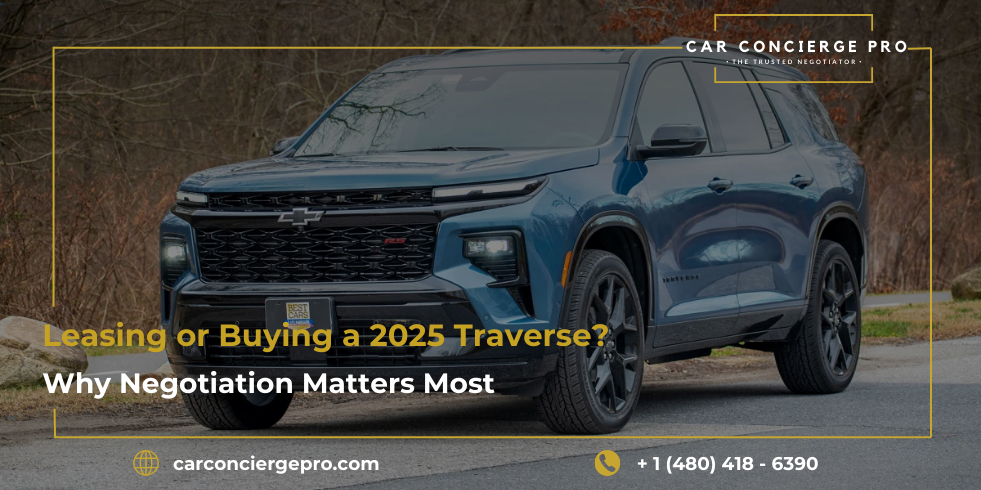If you’re eyeing the 2025 Traverse, you’re not alone. With Chevy’s newly updated SUV turning heads, many buyers and lessees are asking the same question: should I lease or buy the 2025 Traverse? And more importantly, does negotiating really make that much of a difference in today’s car market?
The short answer: absolutely. With market fluctuations, tighter inventory, and evolving buyer incentives, the art of negotiation is no longer optional—it’s essential.
This guide dives deep into the pros and cons of leasing vs. buying the 2025 Chevy Traverse, how to calculate total costs, and why negotiation can save you thousands. Whether you’re upgrading for your family or trading in a lease, the right strategy starts here.
Table of Contents
Toggle2025 Chevy Traverse: What’s New This Year?
Before deciding whether to lease or buy, it’s worth understanding what makes the 2025 Chevy Traverse a hot topic in the SUV segment.
Redesigned Styling and Performance
The 2025 Traverse introduces a bolder, more aggressive exterior, reminiscent of the Tahoe’s muscular look. Under the hood, Chevy now offers a turbocharged 2.5L engine, replacing the previous V6. While some purists may lament the change, this upgrade increases torque and improves fuel economy—something lease customers will love.
Technology and Safety Upgrades
Standard features now include Chevy Safety Assist, a 17.7-inch infotainment screen, and wireless Apple CarPlay/Android Auto. Trim levels like the Z71 bring off-road capability, making the Traverse more versatile. These enhancements also increase residual value, which affects both lease pricing and long-term ownership ROI.
Lease vs. Buy: Which Makes More Sense for the 2025 Traverse?
There’s no one-size-fits-all answer. Choosing to lease a 2025 Traverse or buy one depends on your lifestyle, finances, and how long you plan to keep the vehicle.
When Leasing the Traverse Is a Smart Move
- Short-Term Use: Planning to drive it for 2–3 years? Leasing keeps you in the latest model with lower payments.
- Lower Upfront Costs: Often requires less cash down and no long-term commitment.
- Warranty Coverage: Most lease terms fall within the bumper-to-bumper warranty, minimizing out-of-pocket repairs.
- Tax Benefits: Business owners may write off lease payments.
Why Buying the Traverse May Be Better Long-Term
- Equity & Ownership: After loan payoff, the Traverse is yours—no mileage penalties, no wear-and-tear fees.
- Customization Freedom: Add accessories or make modifications without lease restrictions.
- Cheaper Over Time: Over 6–8 years, buying typically becomes more cost-effective.
- Resale Value: The Traverse holds resale value well—especially higher trims like RS or Z71.
Real Costs: Lease Deals vs. Ownership Expenses
Let’s break down actual cost scenarios using current dealer incentives and average Traverse pricing.
Monthly Payments Comparison
- Lease: $499/month for 36 months with ~$3,500 due at signing (based on current national average).
- Buy: $44,000 MSRP / $7,000 down / 6-year loan at 6% = ~$630/month.
→ Over 3 years:
- Lease: ~$21,464 (including fees).
- Buy: ~$27,680 in payments + depreciation.
But at the end of 6 years, a buyer might still have ~$20K in vehicle value, while a lessee walks away with no equity.
Hidden Costs to Watch
- Lease:
- Mileage penalties: ~$0.25/mile over 36,000 miles.
- Wear & tear charges.
- Mileage penalties: ~$0.25/mile over 36,000 miles.
- Buy:
- Maintenance post-warranty.
- Higher insurance in the early loan period.
- Maintenance post-warranty.
Why Negotiation Matters More Than Ever in 2025
Dealerships are playing hardball in 2025. High demand and inventory management mean sticker price isn’t always the ceiling—but it’s certainly not the floor unless you know how to negotiate.
Dealer Strategies and How to Counter Them
- “This price is non-negotiable.” → Always verify with at least 2 other dealerships.
- Bundling packages you don’t want. → Decline add-ons like VIN etching, paint protection.
- Lowball trade-in offers. → Use Kelley Blue Book or Carvana for reference before visiting.
How to Leverage Market Conditions
- Time your purchase: End of the month, quarter, or model year = better deals.
- Incentives: Look for conquest bonuses, loyalty cash, and regional lease specials.
- Inventory pressure: Smaller dealers may need to move units faster.
Practical Negotiation Tips for the 2025 Traverse
Before You Walk Into the Dealership
- Know the invoice price, not just MSRP.
- Get pre-approved for financing—dealers make money on loans, so this is leverage.
- Use email to start: It gives you time to respond, compare offers, and avoid pressure.
At the Negotiation Table: Scripts & Phrases
- “Can you break down the numbers? Let’s go line by line.”
- “This offer looks high—can you do better if I sign today?”
- “Dealer X is offering $XX—can you match or beat that?”
Common Mistakes to Avoid When Shopping for the Traverse
- Focusing only on monthly payments. Total cost matters more.
- Skipping the test drive. Not all trims ride the same—RS vs. Z71 feel very different.
- Not checking inventory ahead. Know what’s on the lot to avoid bait-and-switch.
- Leasing without understanding mileage limits. These add up fast—especially for commuters.
Final Thoughts: The Power of an Informed Decision
Whether you’re leaning toward leasing or buying the 2025 Traverse, the key takeaway is this: knowledge and negotiation give you power. Don’t walk into the dealership blind. Understand pricing, market conditions, and your personal goals.
When you combine this insight with smart negotiation, you’ll avoid overpaying—and drive away knowing you made the best financial choice for your lifestyle.
FAQs
- Is it better to lease or buy the 2025 Traverse?
It depends on your needs. Leasing offers lower monthly payments and new-car turnover every few years, while buying builds equity and can be cheaper long-term. - What’s new in the 2025 Chevy Traverse?
The 2025 Traverse features a turbo engine, rugged new styling, updated safety tech, and a massive infotainment screen—all standard. - Can you negotiate lease deals on a 2025 Traverse?
Yes, absolutely. You can negotiate cap cost, money factor, and even residuals. Shop multiple dealers for the best lease terms. - How much does it cost to buy a 2025 Traverse?
The base model starts around $38,000, with higher trims like Z71 or RS pushing into the $50,000+ range before options or fees. - What are common lease pitfalls with the 2025 Traverse?
Watch out for mileage caps, high fees on wear and tear, and unnecessary dealer add-ons baked into the monthly cost. - How long does it take to break even when buying a 2025 Traverse?
Typically, buyers break even (compared to leasing) after 5–6 years of ownership, depending on depreciation and maintenance. - Are there any SUV lease deals for the 2025 Traverse right now?
Yes, many regional dealers are offering incentives, especially for returning lessees or conquest customers—check local ads and manufacturer specials.




 and Canada
and Canada 





